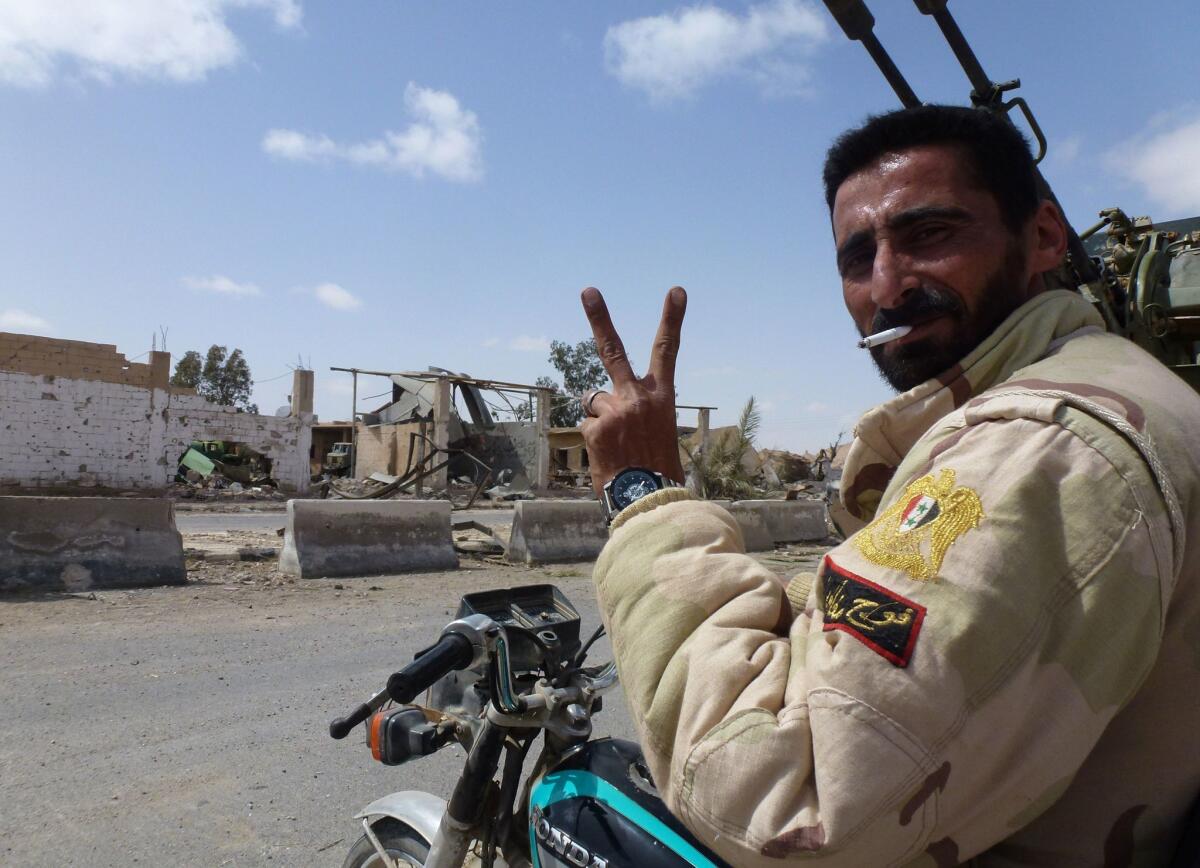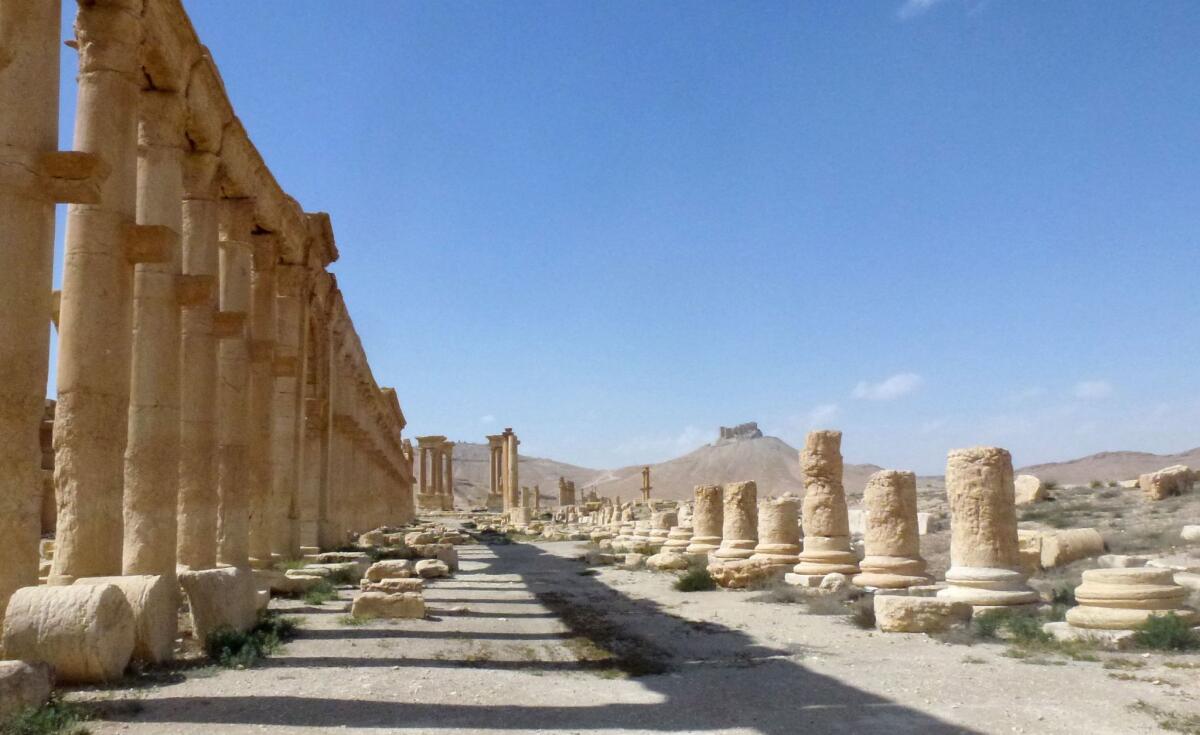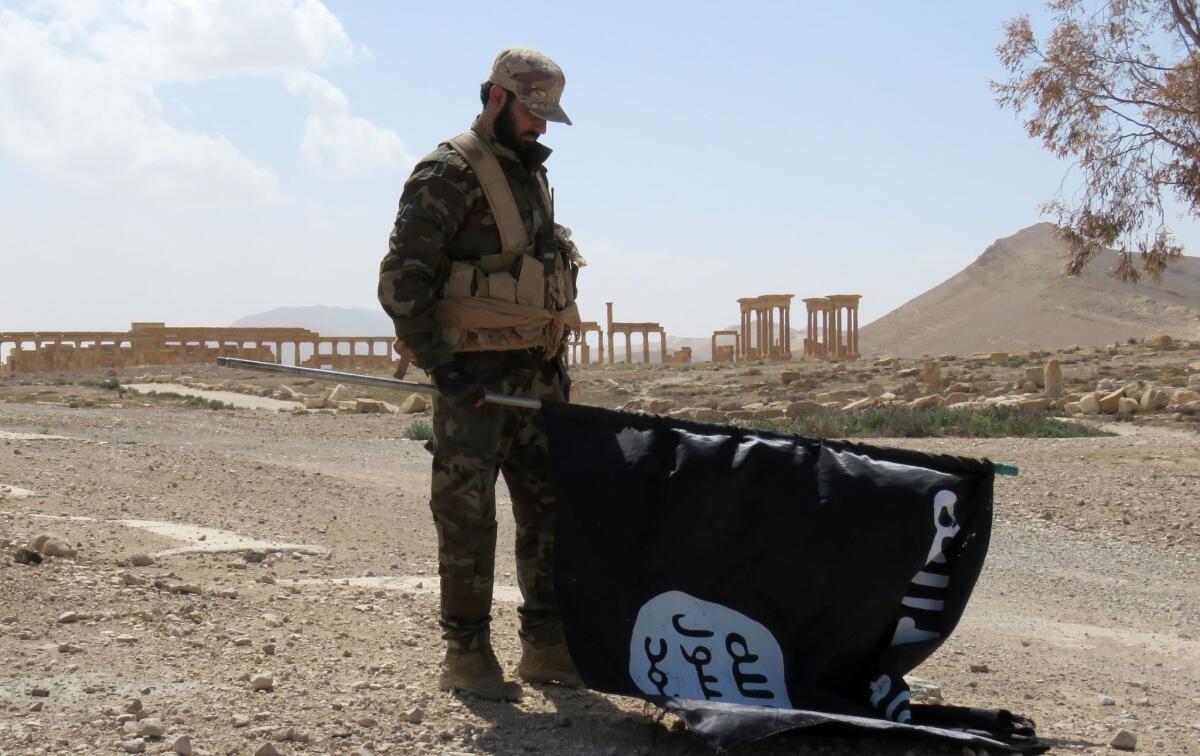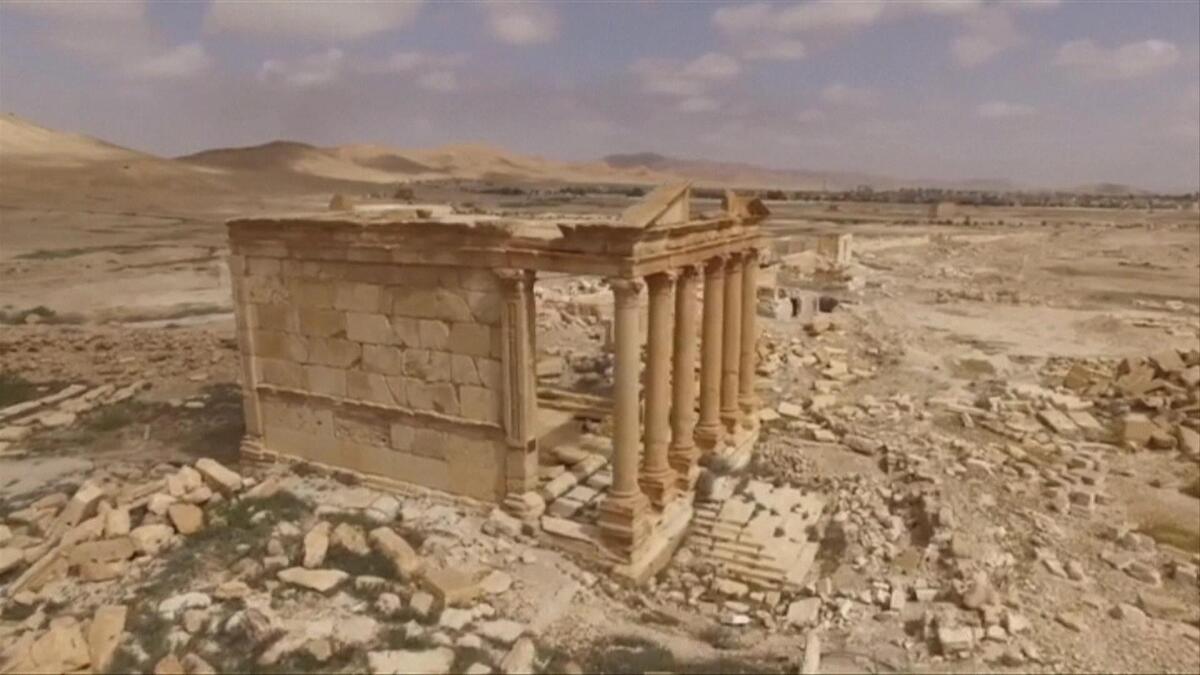Analysis:: Syrian army’s blow to Islamic State presents a paradox for Obama

A member of the Syrian pro-government forces flashes the victory sign in a residential neighborhood of Palmyra, after troops recaptured the city from Islamic State.
Even before Syrian government forces officially took back the city of Palmyra on Sunday, its prospective liberation from Islamic State militants had won widespread applause and relief.
“For one year, Palmyra has been a symbol of the cultural cleansing plaguing the Middle East,” Irina Bokova, the director-general of United Nations Educational, Scientific and Cultural Organization (UNESCO) said in a statement last week, as Syrian forces closed in on the ancient city and its spectacular Roman-era ruins. “The dynamiting and pillage of its treasures, to break an entire society, sparked a unanimous indignation and strengthened the unprecedented mobilization in favor of the values that unite all humanity.”

Ruins in the ancient city of Palmyra, after government troops recaptured the UNESCO world heritage site from Islamic State.
But for the Obama administration and its allies, the retaking of the storied city by the government of Syrian President Bashar Assad, backed by scores of Russian airstrikes, highlights a dilemma: Washington has endeavored to portray the battle against Islamic State as a project of the United States and its allies, while accusing Moscow of attacking “moderate” rebels instead of the extremists. Palmyra seems to embody an alternative narrative.
The White House, which has struggled for years to find effective “partners” on the ground in Syria, has difficulty publicly lauding advances against Islamic State by Assad and his allies, including the Russians and Iranians, after years of calling for Assad’s fall.
Last May, as Islamic State closed in on Palmyra, the U.S.-led aerial coalition that has been pummeling Islamic State in Syria for the past 18 months took no action to prevent the extremists’ advance toward the historic town — which, until then, had remained in the hands of the sorely overstretched Syrian security forces. The U.S. approach in Palmyra contrasted dramatically with the very proactive U.S. bombardment of Kobani during 2014-15 on behalf of U.S.-allied Kurdish militias fending off a furious Islamic State offensive.
This was, in part, because the Syrian conflict has developed into a multi-sided proxy war, greatly complicating the fight against Islamic State.
The United States’ major allies in the region, Saudi Arabia and Turkey, are still deeply committed to the fall of Assad and a new government in Damascus more amenable to their interests. Both the Saudis and Turks stepped up aid to their Syrian proxies, mostly various shades of Islamists, in response to the Russian aerial intervention on behalf of Assad’s forces that began in September.
Riyadh and Ankara have repeatedly denied allegations of helping Islamic State and other Al Qaeda-style militants in Syria. But many rebel groups who have been deemed “moderate” and received aid from the United States and its allies acknowledge cooperating with Al Nusra Front, the official Al Qaeda franchise in Syria.
The United States and its geopolitical rivals — Russia, Iran and the Assad government in Syria — all view Islamic State as an enemy to be annihilated. But working together to achieve that goal on the fractured terrain of Syria remains a daunting challenge.
Assad and the Russians have long asserted that his government was the leading bulwark against terrorism in Syria. But the Obama administration has backed a contrary argument: Assad is a “magnet” for Islamic extremists, Washington says, a leader whose violent crackdown on street protests in 2011 sparked the war and drew militants from across the globe to Syria. Once Assad was gone, the U.S. argued, the attraction for Syria-bound jihadists would wane.

A member of the Syrian pro-government forces takes down an Islamic State flag after troops recaptured Palmyra.
The scenes of Syrian government forces taking back the storied town of Palmyra and trampling Islamic State flags provide a contrary image.
And now Assad’s forces may push on to Raqqah, the headquarters of Islamic State’s self-declared caliphate, about 100 miles northeast of Palmyra.
In crafting their Syria policy moving forward, U.S. officials face a paradox. They seek to weaken Assad’s government, but not so much as to boost Islamic State and other militant factions that initially arose from the chaos of the Syrian conflict. U.S. officials say their goal in aiding rebel factions is not to force a violent overthrow of Assad, but to push his government into negotiating concessions that would ultimately see him leave office.
For its part, Washington has been clear that the black flag of Islamic State flying over Damascus would be a catastrophic outcome. As part of the ongoing Geneva peace process, both Washington and Moscow have backed the principle that Syria’s state institutions must remain “intact” through any “transitional” Syrian government that may arise from the peace process.
So far, though, the Assad government has made it clear that its participation in United Nations-backed talks in Geneva is not meant to orchestrate its own demise.
In recent months, the White House has toned down its “Assad must go” demands, conceding that the Syrian president could stay in power for some unspecified period during a transition to a new, negotiated administration in Syria. Still, Washington insists Assad must step down.
But how to maintain a stable government structure in Damascus without Assad and his loyalists remains a key obstacle for negotiators in Geneva. The lessons of neighboring Iraq resonate.

An image from video recorded by a Russian drone on March 27, 2016, shows a temple in the ancient city of Palmyra.
The goal is to avoid the kind of chaos and turmoil that enveloped Iraq in 2003 when the U.S. military ousted Saddam Hussein, resulting in a collapse of the Iraqi state. That set in motion an era of instability and sectarian-fueled violence that continues to this day — and has radiated across the region, sowing chaos.
In fact, Islamic State has its origins in Al Qaeda in Iraq, which emerged from the U.S. occupation and became a potent adversary of Washington and its Iraqi allies. The new war in Syria that began in 2011 drew numerous battle-hardened Islamist fighters from across the border in Iraq.
Many of Islamic State’s current leaders, including the group’s top figure, Abu Bakr Baghdadi, were imprisoned by U.S. forces in Iraq. Just as young militants in Europe become radicalized in prisons, Baghdadi and his confederates appear to have consolidated a sinister strategy of Sunni extremist resistance and expansion during their time at Camp Bucca in southern Iraq.
ALSO
Brussels Islamic militant recruiter groomed young men for violence
In Syria, militias armed by the Pentagon fight those armed by the CIA
Taliban says it targeted Christians in a park on Easter Sunday, killing 70
More to Read
Sign up for Essential California
The most important California stories and recommendations in your inbox every morning.
You may occasionally receive promotional content from the Los Angeles Times.










